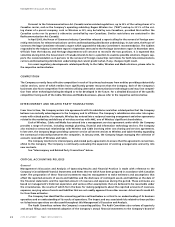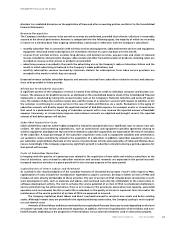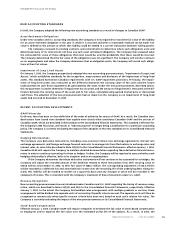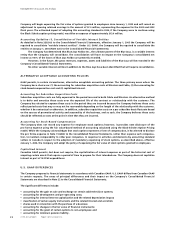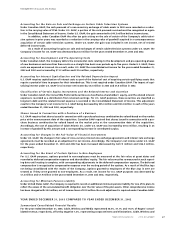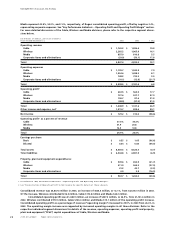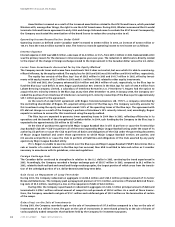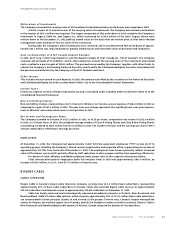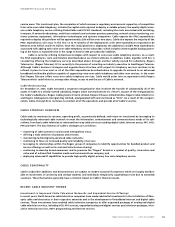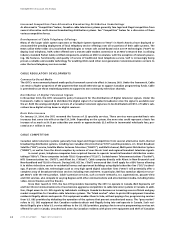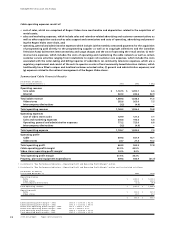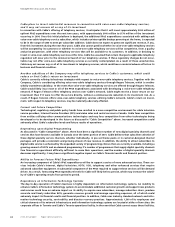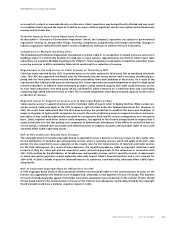Rogers 2003 Annual Report Download - page 34
Download and view the complete annual report
Please find page 34 of the 2003 Rogers annual report below. You can navigate through the pages in the report by either clicking on the pages listed below, or by using the keyword search tool below to find specific information within the annual report.
2003 Annual Report Rogers Communications Inc.
32
Cable Products and Services
With 99% of its network having digital cable available and more than 92% upgraded to 750 Megahertz (“MHz”) or
860 MHz, Rogers Cable has a highly-competitive offer which includes high definition television (“HDTV”), a suite of
‘Rogers on Demand’ services (including video on demand (“VOD”), personal video recorders (“PVR”) and time shifted pro-
gramming), impulse pay-per-view (“PPV”), movies and events as well as a significant line-up of digital, multicultural and
sports programming.
Rogers Cable’s Internet service is available to over 96% of its homes passed. Cable’s Internet service is available to
residential customers in either a High Speed or Rogers Hi-Speed Internet Lite (Internet Lite) service offering. Cable also
offers a full range of data and Internet products to business customers.
Rogers Cable also offers videocassette, digital video disc (“DVD”) and video game sales and rentals through Rogers
Video, Canada’s second largest chain of video stores. There were 279 Rogers Video stores at December 31, 2003, of which
many are integrated stores that provide Rogers customers with the additional ability to purchase cable and wireless
products and services, pay their cable television, Internet or Rogers Wireless bills and to pick up and return cable TV and
Internet equipment.
Cable Distribution Network
In addition to the Rogers Video stores as described above, Cable markets its services through an extensive network of
retail locations across its network footprint, including the Rogers Wireless independent dealer network, Rogers AT&T
Wireless stores and kiosks and major retail chains such as RadioShack Canada Inc., Future Shop Ltd. and Best Buy Canada.
Cable also offers products and services and customer service on its e-business Web site, www.rogers.com.
Cable Networks
Cable’s cable networks in Ontario and New Brunswick, with few exceptions, are interconnected to regional head-ends,
where analog and digital channel line-ups are assembled for distribution to customers and Internet traffic is aggregated
and routed to and from customers, by inter-city fibre-optic rings. The fibre interconnections allow Cable’s multiple
Ontario and New Brunswick cable systems to function as a single cable network. Cable’s remaining subscribers in
Newfoundland and New Brunswick are served by local head-ends. Cable’s two regional head-ends in Toronto, Ontario
and Moncton, New Brunswick provide the source for most television signals used in the cable systems.
Cable’s technology architecture is based on a three-tiered structure of primary hubs, optical nodes and co-axial dis-
tribution. The primary hubs, located in each region that Cable serves, are connected together by inter-city fibre-optic
systems carrying television, Internet, network control and monitoring, and administrative traffic. The fibre-optic systems
are generally constructed as rings that allow signals to flow in and out of each primary hub through two paths, providing
protection from a fibre cut or other disruption. These high-capacity optical fibre networks deliver high performance and reli-
ability, and have substantial reserves for future growth in the form of dark fibre and unused optical wavelengths. Cable’s
primary hubs serve from 4,000 to 248,000 subscribers, with two of the primary hubs each serving over 200,000 subscribers.
Optical fibre joins the primary hub to the optical nodes in the cable distribution plant. Final distribution to sub-
scriber homes from optical nodes uses co-axial cable with two-way amplifiers to support on-demand television and
Internet service. Co-axial cable capacity has been increased repeatedly by introducing more advanced amplifier technolo-
gies. Cable believes co-axial cable is the most cost-effective and widely deployed means of carrying two-way television
and high-speed Internet services to residential subscribers.
Groups of an average of 640 homes are served from each optical node in a cable architecture commonly referred to
as fibre-to-the-feeder (“FTTF”). The FTTF plant provides bandwidth up to 750 MHz or 860 MHz, which includes 37 MHz of
bandwidth used for “upstream” transmission from the subscribers’ premises to the primary hub. Cable believes the
upstream bandwidth is sufficient to support multiple cable modem systems and data traffic from interactive digital set-
top terminals for at least the near term future. When necessary, additional upstream capacity can be provided by
reducing the number of homes served by each optical node. Fibre cable has been placed to permit a reduction of the
average node size from 640 to 300 homes by installing additional optical transceiver modules and optical transmitters and
return receivers in the head-ends and primary hubs.
More than 92% of Cable’s cable plant has been upgraded to 750/860 MHz FTTF architecture, with approximately 96%
of its plant capable of transmitting 550 MHz of bandwidth or greater. Through the completion of Cable’s scheduled network
upgrade program, 96% will be rebuilt to 750/860 MHz FTTF by early 2004 and, by year end 2004, approximately 85% of its net-
work will be upgraded to 860 MHz. Some smaller communities and rural areas continue to use more traditional two-way
cable architectures with 2,000 subscribers per node and 600 MHz bandwidth. Overall, 96% of Cable’s total cable plant was
two-way addressable at December 31, 2003 and 99% of the homes passed in Cable’s service areas had digital cable available.
Cable believes that the 750/860 MHz FTTF architecture provides it with sufficient bandwidth for foreseeable
growth in television, data and future services, a high quality picture, advanced two-way capability and increased reliabil-
ity. In addition, Cable’s clustered network of cable systems served by regional head-ends facilitates the Company’s ability
to rapidly introduce new services to subscribers with a lower capital cost.
Telephony Initiative
Cable, together with RCI, announced an initiative on February 12, 2004, to deploy an advanced broadband Internet
Protocol (IP) multimedia network to support primary line voice-over-cable telephony and other new services across cable
Management’s Discussion and Analysis


